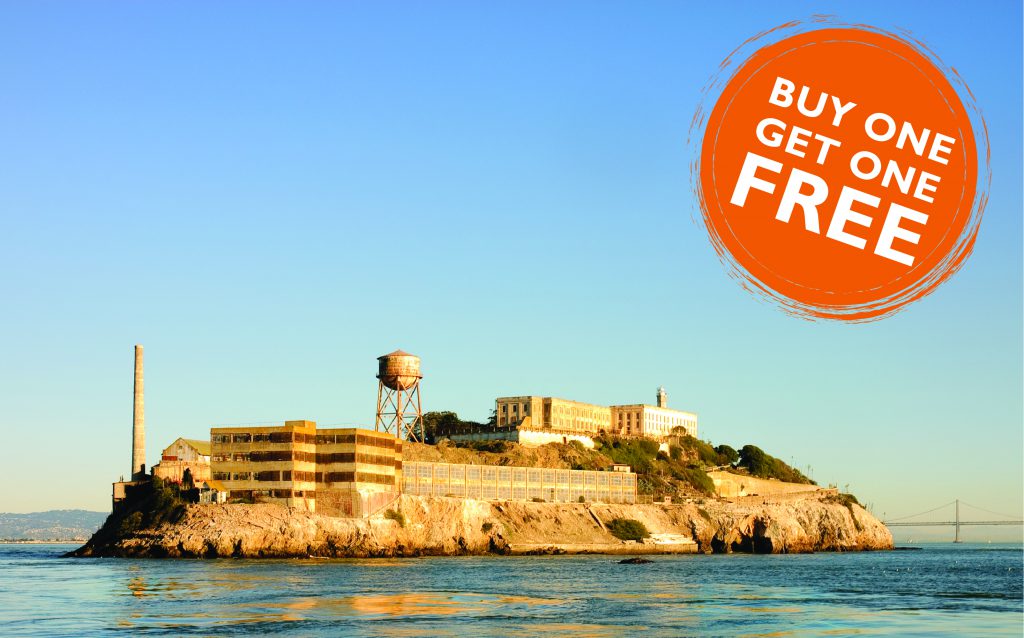Although Alcatraz Cruises’ tours often sell out during the year, it is a priority to educate the community about the robust history of the Island. As a result, Alcatraz Cruises wants to encourage local residents to experience the assets that make Alcatraz Island one of the country’s most visited national parks.
Historia de Alcatraz
"A pesar de lo que te digan, creo que sienten un poco de nostalgia. Creo que van a echar de menos este lugar". - El director de Alcatraz, Fred T. Williamson, cuando los últimos reclusos fueron expulsados en 1963
Few islands in the world can boast such a glorious natural setting – and grim human past – as Alcatraz. Visited by Native Americans as early as 10,000 years ago, the barren island remained uninhabited until Europeans arrived. Spanish and Mexican settlers in the early 1800s called the guano-covered island “Isla de los Alcatraces” – Island of Pelicans.
Poco después de que la isla fuera adquirida a México en 1848, el ejército estadounidense construyó lo que se convertiría en el mayor fuerte de defensa al oeste del río Misisipi durante la Guerra Civil (1861-1865). Alcatraz también se convirtió en un faro para los barcos que entraban en las traicioneras aguas del Golden Gate después de que su faro, el primero de la costa oeste, entrara en servicio en 1854,
Alcatraz began its long era as a dreaded place of confinement when soldier convicts were first imprisoned at the fort in 1860. Over the next decades, the island became less of a defense fort and more of a military prison, with Army convicts building most of the structures still standing on Alcatraz today.
Alcatraz was reborn as a civilian Federal Penitentiary in 1934, becoming known in the press as “The Rock” and “America’s Devil’s Island.” Wardens at Atlanta, Leavenworth, and other federal prisons selected their most unruly convicts to transfer there, among them Al Capone and “Machine Gun” Kelly. No less tough and carefully selected were the correctional officers, one for every three prisoners, who were trained to use their wits as well as their muscles when trouble broke out.
Alcatraz was the most escape-proof prison in the nation. Even if a convict could get past the remote-control locks, guard towers, and barbed wire, he had to struggle against swirling tides and icy waters to reach shore. Yet, escape was uppermost on the minds of many inmates. “Alcatraz is becoming a prison of madmen and men half mad,” Al “The Bug” Loomis, a bank robber once incarcerated there, wrote in 1938. “The sustaining hope is escape.”
A lo largo de los años, los fugados fabricaron unas rudimentarias alas acuáticas y aletas de madera e intentaron nadar, pero se ahogaron o fueron atrapados mientras nadaban. En 1962, el convicto John Paul Scott se convirtió en el primer y único fugado de la penitenciaría que llegó a la costa de San Francisco. Lo descubrieron inconsciente en las rocas de Fort Point, morado y temblando sólo con los calcetines puestos. Demasiado débil para continuar, acabó volviendo al punto de partida.
In that same year, Attorney General Robert F. Kennedy announced the phase-out of the prison. Alcatraz was turned over to the General Services Administration as surplus property and most of the inmates were transferred to a new facility in Marion, Ill. Over the next few years, hundreds of proposals were submitted for new uses for the island, including a West Coast version of the Statue of Liberty, a casino resort, and space museum.
In 1969, a group of 300 Native Americans began a 19-month occupation of Alcatraz, claiming rights to the island under an old Sioux Treaty that gave Native Americans the right to homestead unused federal lands. While the Occupation put a media spotlight on Native American issues, the numbers of activists gradually dwindled and Federal marshals removed the last few from the island in June 1971. Each November Native Americans of many tribes return to Alcatraz to hold a sunrise ceremony commemorating the Occupation.
En 1972, Alcatraz pasó a formar parte de la recién designada Área Recreativa del Golden Gate, una unidad del Servicio de Parques Nacionales. Al año siguiente se iniciaron las visitas a Alcatraz, que ahora atraen a unos 1,7 millones de visitantes al año a un lugar que tantos hombres soñaron con no volver a ver.


